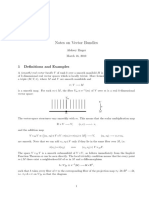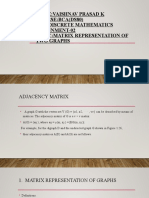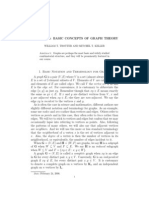HW 03
HW 03
Uploaded by
BobCopyright:
Available Formats
HW 03
HW 03
Uploaded by
BobOriginal Description:
Original Title
Copyright
Available Formats
Share this document
Did you find this document useful?
Is this content inappropriate?
Copyright:
Available Formats
HW 03
HW 03
Uploaded by
BobCopyright:
Available Formats
CS 70 Discrete Mathematics and Probability Theory
Fall 2017 Satish Rao and Kannan Ramchandran
HW 3
Sundry
Before you start your homework, write down your team. Who else did you work with on this
homework? List names and email addresses. (In case of homework party, you can also just describe
the group.) How did you work on this homework? Working in groups of 3-5 will earn credit for
your "Sundry" grade.
Please copy the following statement and sign next to it:
I certify that all solutions are entirely in my words and that I have not looked at another student’s
solutions. I have credited all external sources in this write up.
1 Build-Up Error?
What is wrong with the following "proof"?
False Claim: If every vertex in an undirected graph has degree at least 1, then the graph is con-
nected.
Proof: We use induction on the number of vertices n ≥ 1.
Base case: There is only one graph with a single vertex and it has degree 0. Therefore, the base
case is vacuously true, since the if-part is false.
Inductive hypothesis: Assume the claim is true for some n ≥ 1.
Inductive step: We prove the claim is also true for n+1. Consider an undirected graph on n vertices
in which every vertex has degree at least 1. By the inductive hypothesis, this graph is connected.
Now add one more vertex x to obtain a graph on (n + 1) vertices, as shown below.
CS 70, Fall 2017, HW 3 1
10 Graph Theory
connected; that is, there is a path between every pair of vertices. Now we add one more
vertex x to obtain an (n + 1)-vertex graph:
n − vertex graph
All that remains is to check that there is a path from x to every other vertex z. Since x
All that remains ishasto check that there is a path from x to every other vertex z. Since x has degree
degree at least one, there is an edge from x to some other vertex; call it y. Thus, we
at least 1, there is can
an obtain
edgea from x tox tosome
path from other vertex;
z by adjoining calltoitthe
the edge x—y Thus,
y. path fromwey to can obtain a path from x
z. This
proves P (n + 1).
to z by adjoining the edge {x, y} to the path from y to z. This proves the claim for n + 1.
By the principle of induction P (n) is true for all n 1, which proves the theorem.
That looks fine! Where is the bug? It turns out that faulty assumption underlying
2 Proofs in Graphs
this argument is that every (n + 1)-vertex graph with minimum degree 1 can be obtained from
an n-vertex graph with minimum degree 1 by adding 1 more vertex. Instead of starting by
considering an arbitrary (n + 1)- node graph, this proof only considered an (n + 1)-node
graph that you can make by starting with an n-node graph with minimum degree 1.
Please prove or disprove the following claims.
The counterexample above shows that this assumption is false; there is no way to build
that 4-vertex graph from a 3-vertex graph with minimum degree 1. Thus the first error in
the proof is the statement “This proves P (n + 1)”.
(a) In Old California, all roads were one way streets. Suppose Old California had n cities (n ≥ 2)
More generally, this is an example of “build-up error”. Generally, this arises from a
such that for every pair of cities
faulty assumption and
Xsize
that every n +Y1 ,graph
either hadproperty
withXsome a road canto
be Y or up”
“built Y had
from a road to X. Prove
a size n graph with the same property. (This assumption is correct for some properties,
or disprove that there existed a city which was reachable from every other city by traveling
but incorrect for others— such as the one in the argument above.)
through at mostOne 2 roads.
way to avoid an accidental build-up error is to use a “shrink down, grow back”
process in the inductive step: start with a size n + 1 graph, remove a vertex (or edge),
[Hint: Induction]
apply the inductive hypothesis P (n) to the smaller graph, and then add back the vertex
(or edge) and argue that P (n + 1) holds. Let’s see what would have happened if we’d
(b) In lecture, wetried to prove the claim above by this method:
have shown that a connected undirected graph has an Eulerian tour if and only
Inductive step: We must show that P (n) implies P (n + 1) for all n 1. Consider an (n + 1)-
if every vertexvertex
hasgraph
evenG degree.
in which every vertex has degree at least 1. Remove an arbitrary vertex v,
leaving an n-vertex graph G0 in which every vertex has degree... uh-oh!
Consider a connected graph G with n vertices which has exactly 2m vertices of odd degree,
The reduced graph G0 might contain a vertex of degree 0, making the inductive hy-
where m > 0.pothesis or inapplicable!
ProveP (n) disprove We are there
that stuck— are
and properly
m walks so, since
thatthetogether
claim is false!
cover all the edges of G
(i.e., each edge of G occurs in exactly one of the m walks, and each of the walks should not
contain any particular edge more than once).
3 Connectivity
Consider the following claims regarding connectivity:
(a) Prove: If G is a graph with n vertices such that for any two non-adjacent vertices u and v, it
holds that deg u + deg v ≥ n − 1, then G is connected.
[Hint: Show something more specific: for any two non-adjacent vertices u and v, there must
be a vertex w such that u and v are both adjacent to w.]
(b) Give an example to show that if the condition deg u + deg v ≥ n − 1 is replaced with deg u +
deg v ≥ n − 2, then G is not necessarily connected.
(c) Prove: For a graph G with n vertices, if the degree of each vertex is at least n/2, then G is
connected.
CS 70, Fall 2017, HW 3 2
(d) Prove: If there are exactly two vertices with odd degrees in a graph, then they must be con-
nected to each other (meaning, there is a path connecting these two vertices).
[Hint: Proof by contradiction.]
4 Leaves in a Tree
A leaf in a tree is a vertex with degree 1.
(a) Consider a tree with n ≥ 3 vertices. What is the largest possible number of leaves the tree
could have? Prove that this maximum m is possible to achieve, and further that there cannot
exist a tree with more than m leaves.
(b) Prove that every tree on n ≥ 2 vertices must have at least two leaves.
5 Coloring Trees
(a) What is the minimum number of colors needed to color a tree? Prove your claim.
(b) Prove that all trees are bipartite.
[Hint: How does your answer to part (a) relate to this?]
6 Edge-Disjoint Paths in a Hypercube
Prove that between any two distinct vertices x, y in the n-dimensional hypercube graph, there are
at least n edge-disjoint paths from x to y (i.e., no two paths share an edge, though they may share
vertices).
CS 70, Fall 2017, HW 3 3
You might also like
- Eco Umberto Interpreting Serials PDFDocument18 pagesEco Umberto Interpreting Serials PDFHeliosa von OpetiNo ratings yet
- Concrete at High Temperatures - Material Properties and Mathematical ModelsDocument5 pagesConcrete at High Temperatures - Material Properties and Mathematical ModelsWladimir Gonzalez Velez0% (1)
- Annual Report CEVADocument102 pagesAnnual Report CEVAEko Budi WicaksonoNo ratings yet
- Problem Set 5 SolutionsDocument7 pagesProblem Set 5 SolutionsASNo ratings yet
- 2019BMC IreneLo GraphTheory Handout 0Document14 pages2019BMC IreneLo GraphTheory Handout 0Phạm Hải ĐăngNo ratings yet
- Question 2Document3 pagesQuestion 2mahiverma.2727No ratings yet
- M222 GraphsDocument17 pagesM222 GraphspeuyNo ratings yet
- Solutions1 3Document15 pagesSolutions1 3Peter ArmaosNo ratings yet
- Graph_theoryDocument12 pagesGraph_theorykeshav bhutadaNo ratings yet
- TST IMO 2014 SolsDocument7 pagesTST IMO 2014 Solsath mNo ratings yet
- Group Theorem QuestionsDocument35 pagesGroup Theorem QuestionsJack WangNo ratings yet
- RegionDocument6 pagesRegionNersés AramianNo ratings yet
- Repn Theory ExerciseDocument21 pagesRepn Theory ExerciseLuisNo ratings yet
- Graph Theory: Adithya Bhaskar January 28, 2016Document5 pagesGraph Theory: Adithya Bhaskar January 28, 2016zarif hossainNo ratings yet
- Extrem Combin Soln PDFDocument2 pagesExtrem Combin Soln PDFAnonymous kgOgPrNo ratings yet
- Mathematical Foundations of Computer Science Lecture OutlineDocument3 pagesMathematical Foundations of Computer Science Lecture OutlineChenyang FangNo ratings yet
- Assignment 3: Joseph Sharp Luevano (Sharplue) Tingyu Liang (Liangt19)Document4 pagesAssignment 3: Joseph Sharp Luevano (Sharplue) Tingyu Liang (Liangt19)王乔峪No ratings yet
- Lecture 9Document6 pagesLecture 9m22ai569No ratings yet
- Hints Bmv1Document46 pagesHints Bmv1sasidharchennamsettyNo ratings yet
- Notes2 Covering SpacesDocument8 pagesNotes2 Covering SpacesMutt3012No ratings yet
- Graph Theory ProblemsDocument9 pagesGraph Theory ProblemspoluruNo ratings yet
- Ham Path NotesDocument3 pagesHam Path Notesrandomcomments0000No ratings yet
- MAST30011 Graph Theory Practical Class 1Document2 pagesMAST30011 Graph Theory Practical Class 1Jack WangNo ratings yet
- Graphs, DFS, BFS, SP, ST AlgorithmsDocument31 pagesGraphs, DFS, BFS, SP, ST Algorithmsnajiullah khanNo ratings yet
- Random Topics in Graph TheoryDocument43 pagesRandom Topics in Graph TheoryJuta KawalerowiczNo ratings yet
- Graph Theory QBDocument24 pagesGraph Theory QBRevathi SaravananNo ratings yet
- Mathematical Foundations of Computer Science Lecture OutlineDocument3 pagesMathematical Foundations of Computer Science Lecture OutlineChenyang FangNo ratings yet
- BijectionsDocument2 pagesBijectionsDavid DavidNo ratings yet
- Hints BOndy PDFDocument45 pagesHints BOndy PDFhmaravilloNo ratings yet
- Homework 6 SolutionsDocument3 pagesHomework 6 SolutionsAshish GuptaNo ratings yet
- Chapter 01 - GraphsDocument11 pagesChapter 01 - Graphscrybaby.surviving011No ratings yet
- Graph Theory MATH20150Document66 pagesGraph Theory MATH20150Sheetal KanelNo ratings yet
- Calculus Nil 3Document3 pagesCalculus Nil 3Pushpak ShewaleNo ratings yet
- 2004 Bay Area Mathematical Olympiad Problems and Solutions PDFDocument5 pages2004 Bay Area Mathematical Olympiad Problems and Solutions PDFJohnvic AdiqueNo ratings yet
- Analysis ProblemDocument10 pagesAnalysis Problemmanasmondal5566No ratings yet
- Vector BundlesDocument18 pagesVector BundlesARSHPREET MULTANINo ratings yet
- GraphsDocument25 pagesGraphsMR.M.MURALI KRISHNANNo ratings yet
- UDDocument6 pagesUDGURNOORNo ratings yet
- Assignment 1 Due Friday, January 13Document5 pagesAssignment 1 Due Friday, January 13Jasmina Angelevska KostadinoskaNo ratings yet
- GT 1 IntroductionDocument4 pagesGT 1 Introductionelgie liwagonNo ratings yet
- Graph Theory: (Graph Terminology and Handshaking Theorem)Document19 pagesGraph Theory: (Graph Terminology and Handshaking Theorem)vomocem334No ratings yet
- Matrix DM PresentationDocument10 pagesMatrix DM PresentationVaishnav . K JNo ratings yet
- Measuring Lengths - The First Fundamental Form: X U X VDocument8 pagesMeasuring Lengths - The First Fundamental Form: X U X VVasi UtaNo ratings yet
- Unit VDocument74 pagesUnit VvishnuNo ratings yet
- Unit VDocument77 pagesUnit VDarsh RawatNo ratings yet
- 04_10_Degree_sum (1)Document4 pages04_10_Degree_sum (1)Prabhavathy MNo ratings yet
- Basic Concepts of Graph TheoryDocument12 pagesBasic Concepts of Graph TheorySpin FotonioNo ratings yet
- 3 NotesDocument4 pages3 NotesCyrus LiNo ratings yet
- MATH 2113 - Assignment 8: Due: Mar 21Document5 pagesMATH 2113 - Assignment 8: Due: Mar 21Archana ChulliparambilNo ratings yet
- Berkeley Math Circle 2000-2001 Monthly Contest #7 - SolutionsDocument3 pagesBerkeley Math Circle 2000-2001 Monthly Contest #7 - SolutionsChuông GióNo ratings yet
- Caregie Mellon Uni 484 Grah TheoryDocument10 pagesCaregie Mellon Uni 484 Grah TheoryOne PunchNo ratings yet
- MIT6 046JS15 Recitation7Document6 pagesMIT6 046JS15 Recitation7Malsya CantikaNo ratings yet
- R Is Differentiable. We Want To Approximate A Point A Where F Takes F, ,, - . - in Which FDocument3 pagesR Is Differentiable. We Want To Approximate A Point A Where F Takes F, ,, - . - in Which Fnellai kumarNo ratings yet
- Connections and Covariant DerivativesDocument8 pagesConnections and Covariant DerivativesNguyễn Duy KhánhNo ratings yet
- Finite GroupsDocument127 pagesFinite Groupstoura8No ratings yet
- Lec 2Document7 pagesLec 2xigon53558No ratings yet
- Midterm SolutionsDocument19 pagesMidterm Solutionsaqp1118179No ratings yet
- Project (1) Differential EquationsDocument4 pagesProject (1) Differential EquationsAna RangelNo ratings yet
- 4 QuasiDocument5 pages4 QuasiPloni AlmoniNo ratings yet
- Cosmology in (2 + 1) -Dimensions, Cyclic Models, and Deformations of M2,1From EverandCosmology in (2 + 1) -Dimensions, Cyclic Models, and Deformations of M2,1No ratings yet
- Cohomology of Quotients in Symplectic and Algebraic GeometryFrom EverandCohomology of Quotients in Symplectic and Algebraic GeometryNo ratings yet
- Understanding Psychology McGraw-HillDocument1 pageUnderstanding Psychology McGraw-HillKeeLia SmithNo ratings yet
- Research and DevDocument14 pagesResearch and DevP NjroNo ratings yet
- Ion Exchange - Simple To UnderstandDocument140 pagesIon Exchange - Simple To UnderstandAlaitzB100% (3)
- (BS ISO 12913-1 - 2014) - Acoustics. Soundscape. Definition and Conceptual Framework PDFDocument16 pages(BS ISO 12913-1 - 2014) - Acoustics. Soundscape. Definition and Conceptual Framework PDFwilson ardilaNo ratings yet
- Unit 7 Study GuideDocument4 pagesUnit 7 Study Guideapi-323808986No ratings yet
- Mcdonald Supply ChainDocument5 pagesMcdonald Supply ChainAmitNo ratings yet
- ResourceDocument32 pagesResourceMarko ZavbiNo ratings yet
- Meningkatkan Minat Berwirausaha Mahasiswa Di Jawa TimurDocument10 pagesMeningkatkan Minat Berwirausaha Mahasiswa Di Jawa TimurMiaFirda AudinaNo ratings yet
- Annex B Architectural 040219Document79 pagesAnnex B Architectural 040219Nhel Albrecht Babalcon100% (1)
- VU-Assignment MCM-301Document2 pagesVU-Assignment MCM-301mc220203866 JAWAD SARWARNo ratings yet
- Postgraduate Admission List 2019 - 2020 Academic Year 1Document40 pagesPostgraduate Admission List 2019 - 2020 Academic Year 1Kendra FouetsopNo ratings yet
- Doctoral Thesis: Advanced Techniques For Seismic Vibration ControlDocument4 pagesDoctoral Thesis: Advanced Techniques For Seismic Vibration ControlGanesh KumarNo ratings yet
- Apni Kaksha: (Cos) + (Sin) Cos SinDocument3 pagesApni Kaksha: (Cos) + (Sin) Cos Sinhimanshu PANGARIYANo ratings yet
- Nikos Salingaros-Architecture, Patterns, and Mathematics PDFDocument11 pagesNikos Salingaros-Architecture, Patterns, and Mathematics PDFIacubenco AlexandrNo ratings yet
- Software Requirements SpecificationDocument16 pagesSoftware Requirements Specificationमृत्युंजय शर्माNo ratings yet
- API 618 TutorialDocument14 pagesAPI 618 TutorialRhama Wijaya100% (1)
- The Sophic Fire by John PontanusDocument3 pagesThe Sophic Fire by John PontanusAyan KohnNo ratings yet
- Book 2 - Chapter 7 FractionsDocument25 pagesBook 2 - Chapter 7 FractionsJMGNo ratings yet
- Electrostatic 3Document26 pagesElectrostatic 3nozel77No ratings yet
- NF (K.K FCGKJ Dsunzh Fo'Ofo - Ky : Central University of South BiharDocument3 pagesNF (K.K FCGKJ Dsunzh Fo'Ofo - Ky : Central University of South BiharRAJEEVNo ratings yet
- Penurunan Kadar Sianida Limbah Cair Industri Tapioka Dengan Larutan Kapur Tohor (Ca (Oh) ) Di Desa Ngemplak Kidul, Margoyoso, PatiDocument10 pagesPenurunan Kadar Sianida Limbah Cair Industri Tapioka Dengan Larutan Kapur Tohor (Ca (Oh) ) Di Desa Ngemplak Kidul, Margoyoso, PatiFarhan Muhammad IskandarNo ratings yet
- BTEchLEETFinal 85 PB RefinedDocument6 pagesBTEchLEETFinal 85 PB RefinedGur PreetNo ratings yet
- Carry Out Measurements and CalculationsDocument2 pagesCarry Out Measurements and CalculationsRAMON ENRIQUEZ HIGH SCHOOL67% (3)
- Me Full Time 2010Document90 pagesMe Full Time 2010snehilj_1No ratings yet
- Assignment 1 - Introduction To FlowchartsDocument4 pagesAssignment 1 - Introduction To Flowchartsshibly.nomany.khanNo ratings yet
- Grammar Practice - Reinforcement. Unit 2: Out & About 2Document3 pagesGrammar Practice - Reinforcement. Unit 2: Out & About 2Virginia Ruiz JimenezNo ratings yet
- File Shakuntala Devi 1 1616398872Document5 pagesFile Shakuntala Devi 1 1616398872Asad MemonNo ratings yet

























































































